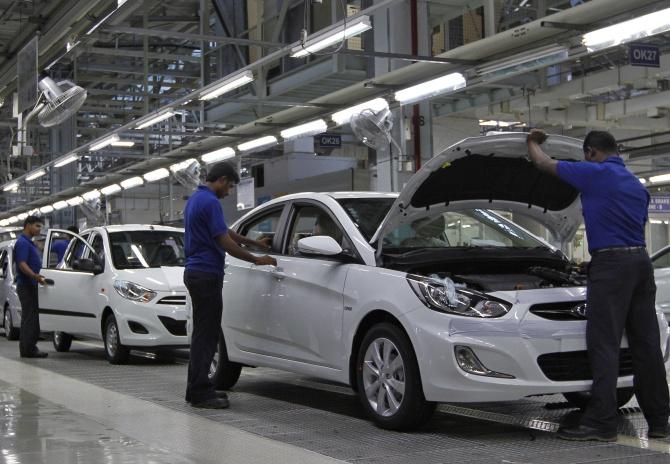Contractual labour is vulnerable independent of whether it is engaged by the organised sector or the unorganised sector, says Mahesh Vyas.

The automobile industry is tiered in manufacturing and in distribution. There are automobile manufacturers, ancillary units, which themselves are quite tiered and then there are the distributors and showrooms.
A fall in automobile demand can, as it already has, hit the entire chain.
All kinds of workers can be hit, but the most vulnerable are the contractual labour. The automobile industry engages contractual labour in a big way.
Millions of jobs are at stake in this industry.
According to the Annual Survey of Industries (ASI), the manufacture of motor vehicles, trailers and semi-trailers involved 987,191 employees and manufacture of motorcycles employed another 209,219 in 2016-17. This adds up to about 1.2 million.
Using the trend in the past decade, we can assume this number has gone up to about 1.4 million. This is significant employment in absolute numbers. The automobile sector employs 8 per cent of the total employment in all industries.
But, the ASI covers only the organised manufacturing sector. These are factories employing over 14.9 million.
It does not include the unorganised manufacturing sector which serves the automobile sector in a big way.
Further, this does not include dealers and distributors who hold the stock for automobile manufacturers and are often particularly stressed during a downturn.
Newspaper reports attributed to Federation of Automobile Dealers Association suggest that 200 car showrooms have been shutdown in the last one year leading to job loss of 25,000 people.
The Automotive Component Manufacturers Association of India has reportedly stated that a million jobs were lost during the last one year. Most were contractual labour.
ACMA suggests there are 5 million workers in the auto component industry. This is five times the employment seen in the ASI.
More importantly, ACMA claims that around 70 per cent or about 3.5 million are hired on contract. These contractual labourers are vulnerable during a downturn like being witnessed now.
According to the ASI, 40 per cent of the total employees of the organised automobile manufacturing sector were hired through labour contractors.
If we assume that these contractually hired employees are all workers and not supervisors or managers, then 50 per cent of all workers of the organised automobile industry are contractual labour.
During the past three years, the government has encouraged contractual employment. It is likely that the share of contractual labour has therefore increased since the ASI data of 2016-17.
These contractual labourers can be fired without much ado. Their number could easily be of the order of half a million in the organised automobiles sector. They were 475,554 in 2016-17, according to the ASI.
Jobs of these half a million contractual workers are not any more secure than those who are employed contractually in the unorganised sector.
Using ACMA's estimate of 5 million workers which includes organised and unorganised sectors then, we can estimate that around 3 million contractual workers are employed in the unorganised sector.
This is a very large number of workers who are vulnerable to the current slowdown in the automobile industry.
According to the ASI, contractual workers in the organised manufacturing sector was 4.2 million in 2016-17. This accounted for 36 per cent of all workers in the year.
The share of contractual labour in total workers in the organised manufacturing sector has increased from 20 per cent in 2000-01 to 30 per cent in 2006-07 to 36 per cent in 2016-17. It is likely to have risen further in the past couple of years.
Contractual labour is vulnerable independent of whether it is engaged by the organised sector or the unorganised sector.
Further, as research working paper shows, they also hurt regular employees.
Radhicka Kapoor and PP Krishnapriya in a research paper in April 2017 (Informality in the Formal Sector) use unit level ASI data to show that besides the oft-quoted reason being employment protection legislation, firms use contract workers strategically against unionised regular workers to keep their bargaining power and wage demand in check.
Arvind Panagariya in The Times of India stated that the proposed draft wage code “promises to add to rather than subtract from the current informality in jobs”.
While the new laws being considered are working towards consolidation of laws and improving ease of doing business, it also seems to be excessively interventionist to protect the interest of workers.
There are some good suggestions like on enforcing letters of appointment. Yet, it seems to strengthen the increasing trend towards the informality of employment. This is worrisome.
It may be good to pause and see the mayhem in the automobile industry and to listen to the academics. Informal jobs are not good jobs.
Mahesh Vyas is the MD & CEO of CMIE.









